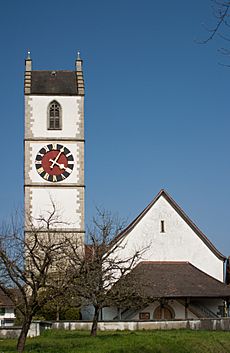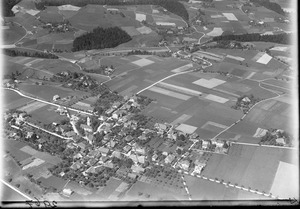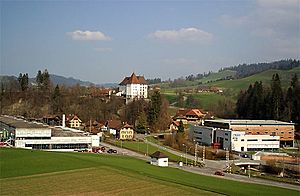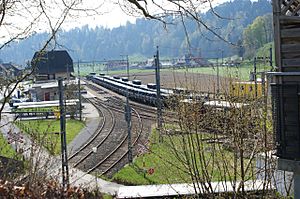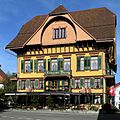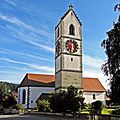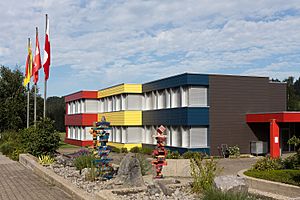Sumiswald facts for kids
Quick facts for kids
Sumiswald
|
||
|---|---|---|
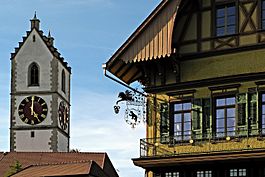 |
||
|
||
| Country | Switzerland | |
| Canton | Bern | |
| District | Emmental | |
| Area | ||
| • Total | 59.34 km2 (22.91 sq mi) | |
| Elevation | 702 m (2,303 ft) | |
| Population
(Dec 2020 )
|
||
| • Total | 5,044 | |
| • Density | 85.002/km2 (220.15/sq mi) | |
| Postal code |
3454
|
|
| Surrounded by | Affoltern im Emmental, Dürrenroth, Eriswil, Langnau im Emmental, Luthern (LU), Lützelflüh, Rüegsau, Trachselwald, Trub, Wyssachen | |
Sumiswald is a town in the Emmental area of Bern canton, Switzerland. It is famous for making the Swiss railway clock, which you might have seen in train stations.
Contents
History of Sumiswald
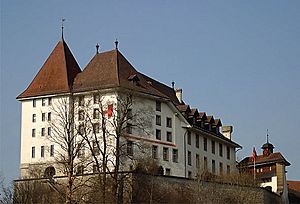
Sumiswald was first mentioned in old writings in 1225. Its name might come from a German settler named "Suomolt." Another idea is that it comes from the Latin words summa vallis, meaning "bank over the valley."
Early Owners and Changes
The Sumiswald family was first mentioned in 1135. They probably got their name from a castle that no longer exists. The last person in this family, Lütold, gave the village and its churches to the Teutonic Knights. This was a group of religious knights.
In 1525, the people of Sumiswald bought their freedom from being like servants (serfs). However, the village stayed with the Teutonic Knights. This was even after the area became Protestant in 1528. Later, in 1698, Sumiswald was sold to the city of Bern for a large sum of money.
The Village Church
The Church of St. Mary in Sumiswald was first mentioned in 1225. The old church was replaced with a new one between 1510 and 1512. When Bern became Protestant, the village also changed its religion. The local government then gained control over the church.
Farming and Trade in Sumiswald
Sumiswald had many mountain pastures. Raising animals in these pastures during different seasons was very important for the local economy. The first agreements about who owned and could use these pastures were made in 1498.
Over the next century, many forests were cleared to make more grazing land for animals. In 1572, the town made laws to stop too much clearing. This was to prevent all the trees from being cut down. Smaller settlements like Wasen, Ey, and Grünen grew from these seasonal animal camps.
Over time, some families became wealthy landowners. Others became poor workers or farmers who rented land. The poorer people started spinning yarn and weaving cloth at home to earn extra money. By the 1700s, Sumiswald was a center for selling yarn, cloth, horses, and cheese.
The town tried to become a market town, where people could hold regular fairs. Other nearby towns blocked this five times. Finally, in 1801, Sumiswald was allowed to hold five fairs each year.
Modern Sumiswald
After the French invasion of Switzerland in 1798, Sumiswald became the capital of a new district. In the 1800s, the local cloth industry slowed down. New industries grew, like making musical instruments.
New roads and railways built in the late 1800s and early 1900s brought more factories. Today, Sumiswald is an important center for culture and business in its region. Many people from nearby villages come to work here. There are also secondary schools and a retirement home in Sumiswald.
Geography of Sumiswald
Sumiswald includes three main villages: Sumiswald, Grünen, and Wasen. It also has two smaller settlements called Gammenthal and Griesbach. Many scattered farmhouses and mountain pastures are found in the lower Emmental area. Sumiswald is one of the largest towns in the canton of Bern.
The town covers about 59.4 square kilometers (22.9 square miles). About 47.9% of this land is used for farming. Forests cover 46.3% of the area. Buildings and roads make up 5.1% of the land. Rivers and lakes cover 0.6%, and a very small part (0.1%) is unproductive land.
Most of the water in Sumiswald is flowing water, like rivers and streams.
Sumiswald's Coat of Arms
The coat of arms for Sumiswald is described as: "A shield split in half. One side is silver with a red bar. The other side is entirely red."
People of Sumiswald
Sumiswald has a population of about 5,028 people (as of December 2012). About 5.5% of the people living here are from other countries.
Languages Spoken
In 2000, most people in Sumiswald (94.0%) spoke German as their main language. The next most common languages were Albanian (1.4%) and Serbo-Croatian (0.9%). A small number of people also spoke French or Italian.
Where People Live
In 2013, about 49.5% of the population was male and 50.5% was female. Most people (47.7%) were born in Sumiswald and still lived there in 2000. Many others (32.9%) were born in the same canton of Bern.
Age Groups
As of 2012, children and teenagers (0–19 years old) make up 21.6% of the population. Adults (20–64 years old) make up 59.0%. Seniors (over 64 years old) make up 19.4%.
Housing in Sumiswald
In 2010, there were 679 homes where only one person lived. There were also 200 homes with five or more people. In 2000, most apartments (87.5%) were lived in all the time. A small number (7.3%) were used only during certain seasons, and 5.2% were empty.
The chart below shows how the population of Sumiswald has changed over time:

Economy and Jobs in Sumiswald
The famous clock maker Moser-Baer is located in Sumiswald. This company makes the well-known Swiss railway clocks.
Employment Overview
In 2011, the unemployment rate in Sumiswald was low, at 1.94%. A total of 2,973 people had jobs in the town.
- Primary sector: 510 people worked in farming and related businesses.
- Secondary sector: 1,228 people worked in manufacturing and construction.
- Tertiary sector: 1,235 people worked in services, like shops, hotels, and healthcare.
About 41.6% of the workers were female.
Commuting and Taxes
In 2000, 981 workers came into Sumiswald for their jobs, and 884 workers left to work elsewhere. This means more people come to Sumiswald for work than leave it. About 65.1% of all workers in Sumiswald also lived there.
Most people (51.3%) used a private car to get to work, while 7.4% used public transportation.
In 2013, the average tax rate for a married resident with two children was 12.0%. For a single resident, it was 18.5%.
Important Buildings and Attractions
The Gasthof Bären (Bären Inn), the village rectory (the house where the church leader lives), and the Swiss Reformed Church are all listed as important national heritage sites in Switzerland. The entire village of Sumiswald is also recognized as an important Swiss heritage site.
Places to Visit
- Church Windows: The glass windows in the Mariekirche church show people who gave money to the church, along with their special patron saints.
- Spittel Castle: The old Teutonic Knight castle is a bit outside Sumiswald. It was given with the rule that it must also have a hospital. That's why it's called Spittel, which means hospital.
- Gasthof Bären: There's a story that after the Black Death plague in 1434, all the men left in Sumiswald could fit around the big table in the "Bären" inn.
Religion in Sumiswald
Based on the 2000 census:
- Most people (80.2%) belonged to the Swiss Reformed Church.
- About 4.3% were Roman Catholic.
- Smaller groups included Orthodox Christians (0.66%), other Christian churches (2.90%), and Muslims (2.68%).
- Some people were Buddhist or Hindu.
- About 3.00% of the population said they had no religion or did not answer.
Education in Sumiswald
In Sumiswald, about 54.6% of people have finished high school (upper secondary education). About 13.8% have gone on to higher education, like a university.
School System
The school system in the Canton of Bern works like this:
- One year of optional kindergarten.
- Six years of primary school.
- Three years of required lower secondary school. Students are grouped by their abilities.
- After lower secondary, students can choose to continue school or start an apprenticeship (learning a trade on the job).
During the 2012–2013 school year, 588 students attended schools in Sumiswald.
- 103 students were in German-language kindergarten classes.
- 294 students were in German-language primary school classes.
- 191 students were in lower secondary school.
Many students (699) lived and went to school in Sumiswald. However, 189 students came from other towns to attend school here. Also, 118 residents of Sumiswald went to school outside the town.
Local Library
Sumiswald has a public library called the Schul- und Gemeindebibliothek Sumiswald. In 2008, it had 9,171 books and other media. It loaned out 28,437 items that year. The library was open for 166 days, averaging 8.5 hours per week.
See also
 In Spanish: Sumiswald para niños
In Spanish: Sumiswald para niños





